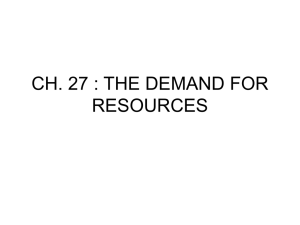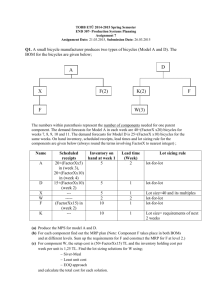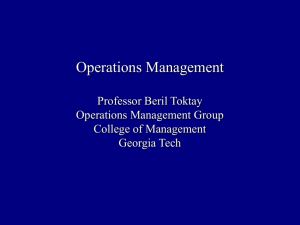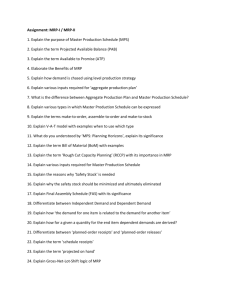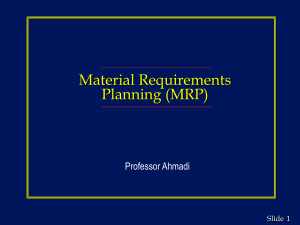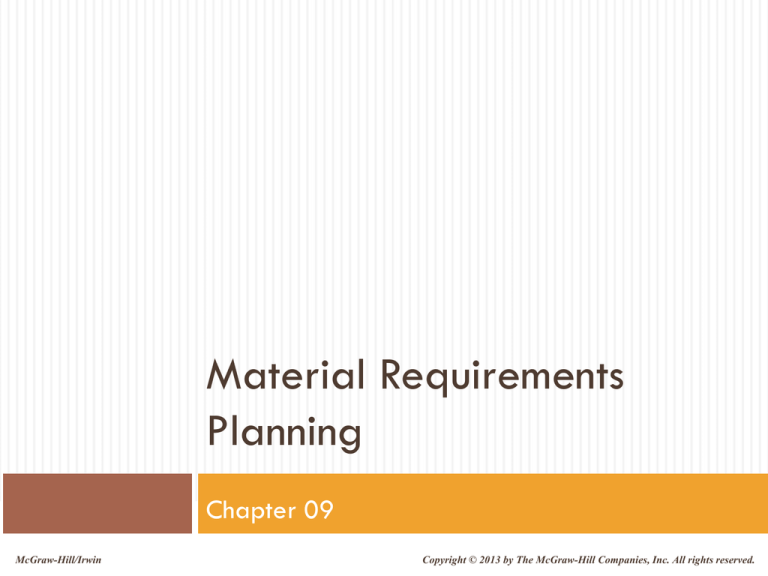
Material Requirements
Planning
Chapter 09
McGraw-Hill/Irwin
Copyright © 2013 by The McGraw-Hill Companies, Inc. All rights reserved.
Learning Objectives
1.
2.
3.
4.
Describe what MRP is and where it is best applied.
Understand the source of the information used by
the system.
Demonstrate how to do an MRP “explosion.”
Explain how order quantities are calculated in
MRP systems.
9-2
Enterprise Resource Planning (ERP) and
Material Requirements Planning (MRP)
ERP - a computer system
that integrates application
programs in accounting,
sales, manufacturing, and
the other functions in a
firm
MRP - a means for
determining the number of
parts, components, and
materials needed to
produce a product
9-3
Material Requirements Planning (MRP)
The logic that ties production functions together from
a material planning and control view.
A logical, easily understood approach to the
problem of managing the parts, components, and
materials needed to produce end items
How
much of each part to obtain?
When to order or produce the parts?
Dependent demand is drives the MPR system
9-4
Master Production Scheduling
The master schedule deals with end items and is a major
input to the MRP process
All production systems have limited capacity and limited
resources
The aggregate plan provides the general range of operation, the
master scheduler must specify exactly what is to be produced
To determine an acceptable feasible schedule to be
released to the shop, trial master production schedules are
tested using the MRP program
9-5
Master Production Scheduling
Aggregate plan shows
overall quantities to
produce – without
specifying type
Week
MPS shows quantities of
each type, with
information about the
production time frame
9-6
MRP System Structure
MRP
system
inputs
MRP
system
outputs
9-7
Product Demand Sources
Customers – specific orders placed by either
external or internal customers
Aggregate production plan – the firm’s strategy for
meeting demand in the future, implemented through
the master production schedule (MPS)
9-8
Bill of Materials (BOM)
Contains the complete product
description, listing the materials,
parts, and components along with
the sequence in which the product
is created
Often called the product structure
file or product tree because it
shows how a product is put
together
The BOM shows
how the product is
put together
Modular bill of materials - a
buildable item that can be
produced and stocked as a
subassembly
Super bill of materials - includes
items with fractional options
9-9
MRP Explosion Process
The requirements for end items are retrieved from the
master schedule
• These are referred to as “gross requirements” by the MRP program
On-hand balance and schedule of orders are used to
calculate the “net requirements”
Net requirements data is used to calculate when
orders should be received to meet these requirements
Planned order releases are generated by offsetting
to allow for lead time
9-10
MRP Explosion Process (continued)
Move to Level 1 items
Gross requirements for each level 1 item are
calculated from the planned-order release
schedule for the parents of each level 1 item
Net requirements, planned-order receipts, and
planned-order releases are calculated as
described in steps 2–4
Repeat for all items in bill of materials
9-11
Lot Sizing in MRP Systems
Determination of
lot sizes in an
MRP system is a
complicated and
difficult problem
Lot sizes - the
part quantities
issued in the
planned order
receipt and
planned order
release sections
of an MRP
schedule
Lot-for-lot (L4L)
Economic order
quantity (EOQ)
Lot Sizing
Strategies
Least total cost
(LTC)
Least unit cost (LUC)
9-12
Lot-for-Lot
Sets planned orders
to exactly match the
net requirements
Produces exactly
what is needed each
week with none
carried over into
future periods
Minimizes carrying
cost
Does not take into
account setup costs or
capacity limitations.
9-13
Economic Order Quantity
Calculate reorder
quantity based on
EOQ
EOQ was not
designed for a system
with discrete time
periods such as MRP
The lot sizes
generated by EOQ
do not always cover
the entire number of
periods
9-14
Least Total Cost/Least Unit Cost
Least total cost method (LTC) - a dynamic lot-sizing
technique that calculates the order quantity by
comparing the carrying cost and the setup costs for
various lot sizes and then selects the lot in which these
are most nearly equal
Influenced by the length of the planning horizon
Least unit cost method (LUC) - a dynamic lot-sizing
technique that adds ordering and inventory carrying
cost for each trial lot size and divides by the number of
units in each lot size, picking the lot size with the lowest
unit cost
9-15

